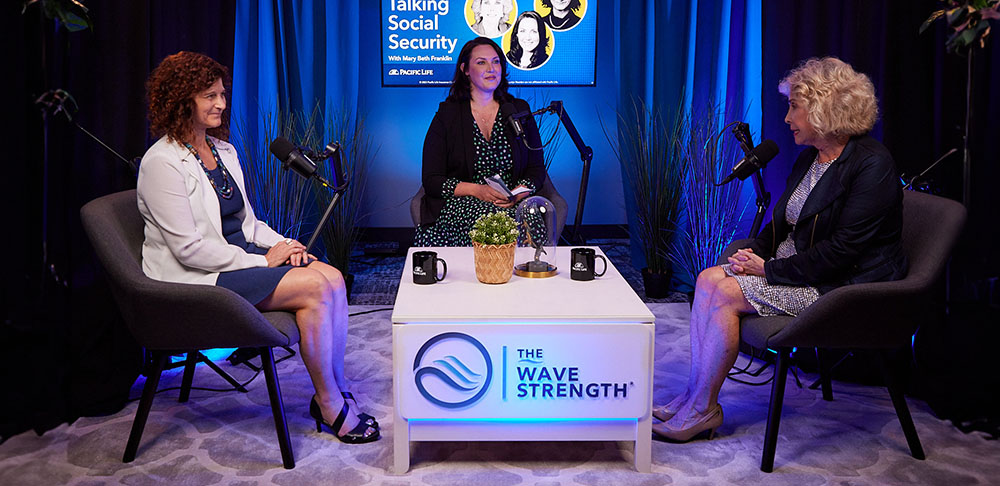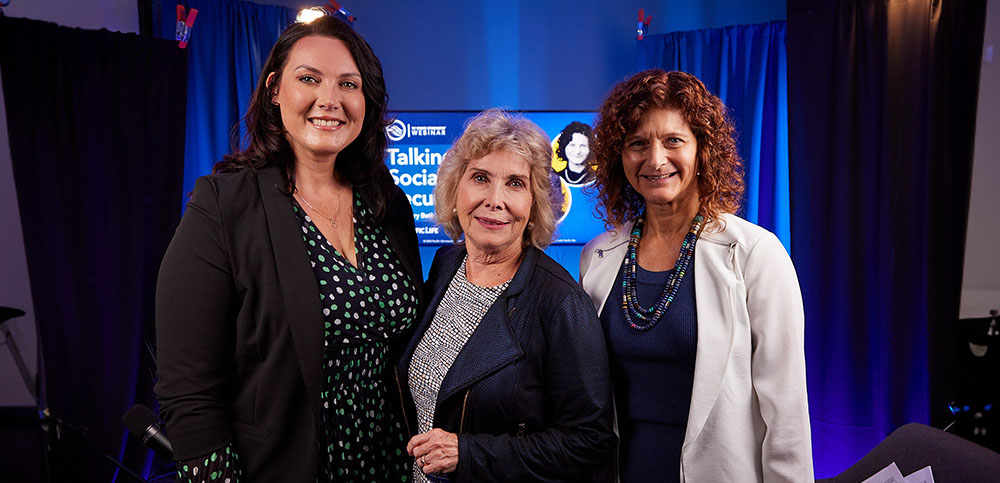This website or its third-party tools use cookies, which are necessary to its functioning and are required to achieve the purposes illustrated in our online privacy policy.
Top Takeaways
- Many people underestimate the importance of financial security in building an emotionally fulfilling retirement.
- The reality for today’s retirement savers is very different from generations in which people could reliably depend on a combination of pensions, Social Security retirement benefits, and personal savings to support them.
- Annuities can help fill the role pensions once filled in the U.S. retirement landscape as a source of lifetime income.
- Financial professionals can help retirees create and execute retirement plans that provide growth potential and manage savings throughout their lifetimes.
Most people intuitively understand the emotional importance of the three pillars of family bonds, social connection, and having a purpose in retirement. But the fourth pillar—financial security—is about more than numbers on a page. It’s just as vital to a senior’s holistic retirement health.
On this episode of The Wave Strength, host Caroline Elrod, Retirement Strategies Group Manager, JD, CLU®, talks with Pacific Life’s Ruth Schau and renowned Certified Financial Planner, Social Security savant, and public speaker Mary Beth Franklin about how retirees can effectively address their financial needs in retirement without sacrificing the emotional element.
Financial Security Is More Than Numbers
When conceptualizing retirement, seniors often make one of two mistakes. The first is thinking of retirement solely in terms of numbers. For these retirees, the planning process may be reduced to striving to save a certain number of dollars. This can be a misguided approach that runs the risk of isolating savers from what makes retirement meaningful: having fulfilling experiences. “Retirement really is more about how you spend your time,” Franklin says, “not just how you spend your money.” It’s important for retirees to see their savings as a tool to facilitate fruitful, emotionally satisfying lives via the other three pillars of retirement—family, purpose, and social connection.
On the other hand, some seniors may neglect the importance of financial security in favor of emotional fulfillment. They may make the mistake of assuming finance is unrelated to emotion—that hard numbers don’t play a role in overall satisfaction. While it’s true that family, purpose, and social connection are all equally important facets of an intrinsically meaningful retirement, retirees should be careful to avoid devaluing their finances. Seniors must first feel secure enough financially to pursue the things that make their lives feel meaningful. “Increasingly, people are looking for secure, guaranteed sources of income so essentially they can sleep well at night,” says Franklin.
The New Retirement-Planning Reality: From Three-Legged Stool to Pogo Stick
Only a few generations ago, pensions predating ERISA's required vesting schedule for benefits were common sources of retirement income—benefits of staying with one employer throughout one’s career. Conventional wisdom established the “three-legged stool” approach to retirement savings, which outlined the three main sources of retirement funds: pensions, Social Security retirement benefits, and personal savings.
These days, that solid three-legged stool has been reduced to a pogo stick. Pensions are no longer a feasible expectation for most Americans, and personal savings are often inadequate to keep up with the ever-increasing demands of inflation. The current reality leaves only Social Security retirement benefits to keep seniors afloat—and Social Security “does have some long-term financing problems,” says Franklin.
With so many exposed to this elevated level of risk, retirees and pre-retirees have been forced to adapt with new savings models. But where should they start?
Rethink Saving with the Retirement Income Pyramid
Mary Beth Franklin has her own suggestion: the Retirement Income Pyramid. The most stable sources of income serve as the foundation of the pyramid, and more incidental or unique sources make up smaller portions toward the top. For example, a hypothetical pyramid might look like this:
- Social Security retirement benefits—This is the nice, solid base of most Americans’ retirement funds. Savers are often most familiar with this income source, as employees pay Social Security payroll taxes for the duration of their careers.
- Retirement-savings plans—These would be savings accounts such as 401(k)s, traditional and Roth IRAs, 403(b)s, etc. The combinations and allocation of funds into these various accounts will depend on the senior’s specific financial and lifestyle circumstances.
- Personal savings and other assets—This layer is characterized by savings accounts, personal investment accounts, CDs, other non-liquid assets, etc. For example, homeowners may consider selling their properties for smaller homes that better meet their needs.
- Incidental income—This makes up the smallest portion of a retiree’s income. These are highly dependent on individual circumstances and will be different for everyone. For example, “Maybe you have income-producing rental property,” Franklin says. “Maybe you have inheritance from your parents. Maybe you have a settlement from a divorce.”
Financial Professionals Can Help the Process
With so many ways to arrange and spend down assets, it can be overwhelming for retirees to decide which strategies to implement. Every Retirement Income Pyramid is different, which means retirees will likely need guidance to work out what’s best for them. This process is further complicated by issues with language.
For example, Mary Beth Franklin and Ruth Schau both agree that they personally see annuities as excellent options for clients looking to add a source of predictable lifetime income to their retirement portfolios. But many clients are intimidated by annuities based on an outdated understanding of what they do. Franklin argues that the function of an annuity can be clarified by financial professionals: “It's protected lifetime income. I think people need to understand this new vocabulary. And if ‘protected lifetime income’ makes them feel more comfortable than ‘annuity,’ let's retire the word ‘annuity.’” Of course, it’s also important to keep in mind that annuities are not right for everyone, and speaking with a financial professional can help retirees determine whether an annuity would be helpful for their specific goals and needs.
About Mary Beth Franklin
As a financial journalist with more than 40 years of experience and a Certified Financial Planner designation, Mary Beth writes about big-picture policy issues, such as the federal budget, tax legislation, and consumer-focused personal finance advice with a focus on Social Security. She has received numerous awards for her publications, and her work has been widely praised for helping both consumers and financial professionals build solid retirement-income plans.
About Ruth Schau
Ruth works with companies and their financial professionals to customize strategies that help address the financial risks inherent to pension plans. Her focus is with organizations who sponsor defined contribution (DC) plans, such as 401(k) or 403 (b) plans, to provide guaranteed lifetime income options for plan participants.
READ MORE

Retirement Planning
Talking Social Security With Mary Beth Franklin
Staying aware of current regulations set by the Social Security Administration can help retirees receive the full benefits they deserve.

Retirement Planning
Optimizing Social Security Benefits with Mary Beth Franklin
Women and other minorities can optimize their strategies for claiming Social Security retirement benefits by keeping a few key ideas in mind.

Retirement Planning
The Financial Pillars of Retirement with Mary Beth Franklin
Many people underestimate the importance of financial security in building an emotionally fulfilling retirement.

Retirement Planning / Family
How Annuities Can Boost Your Retirement Savings
The tax-deferred growth potential of an annuity can boost your savings for the future.

Retirement Planning / Family
How to Enhance Your Retirement Strategy with Cash Value Life Insurance
Your retirement strategy should begin with a tax-advantaged retirement account, but it doesn't have to end there. Supplementing your 401(k) or IRA with cash value life insurance can help give you greater financial flexibility during your lifetime while providing protection to your loved ones.

Family / Estate Planning
What Blended Families Should Know About Estate Planning
An estate plan with an Irrevocable Life Insurance Trust may help reduce estate taxes and ensure equitable distribution of a blended family’s assets.

Family / Estate Planning
Ensuring a Smooth Transition for Your Family Business
A plan that includes life insurance can help provide liquidity and equality in a family business succession.

Home / Estate Planning
How to Help Protect Your Estate Plan from an Uncertain Future
A life insurance trust can help provide flexibility and protection for the future.

Family / Estate Planning
Estate Planning for Unmarried Couples
Life insurance can help maximize wealth transfer for unmarried couples.

Family / Estate Planning
5 Ways Life Insurance Can Help With Estate Planning
As you develop or update an estate plan, considering the following ways life insurance can help address your needs.

Career And Business
Retirement Savings Options at a New Job
Weigh your choices before deciding where—or whether—to move your retirement savings when you switch employers.

Retirement Planning
Ways to Retire Confidently
If you’re concerned about saving enough for retirement, a protected source of income can help put your mind at ease.

Retirement Planning / Home
Don’t Put Off Saving for Retirement
Start building your nest egg early to prepare for the unexpected.

Retirement Planning / Family
Managing Your Beneficiaries’ Inheritance
An annuity with a predetermined beneficiary payout option can offer greater control without a trust.

Retirement Planning
How to Save on Charitable Giving During Retirement
Qualified charitable distributions can help with tax savings and at the same time give to charity during retirement.

Retirement Planning
Picking the Right Type of IRA for You
Understanding the difference between a traditional and Roth IRA can go a long way in planning your retirement savings strategy.

Estate Planning / Family
How to Cope Without the Family Breadwinner
Take these steps to help your loved ones prepare financially in the event the worst happens to you.

Career And Business / Family
A Smart Way for Philanthropists to Give More
A well-designed charitable remainder trust can help lower taxes and aid in financial planning.

Retirement Planning
The Challenges of Living Longer
The good news: Retirees are living longer. The bad news: That may mean retirees will have to fund more years of retirement.

Retirement Planning
Make the Most of Your Retirement With an Informed Income Strategy
Annuities offer another way to put a floor under your retirement income, providing an retirement income stream in exchange for an initial investment. Immediate annuities begin issuing payments soon after you make your investment, while deferred annuities are invested for a period of time before you start taking withdrawals. You can also choose between fixed (-rate) and variable annuities. Fixed annuities earn a guaranteed interest rate over time, while variable annuities are tied to the performance of an investment portfolio. Both provide monthly income for life and protection for your loved ones through a death benefit.

Estate Planning / Family
Finding a Way to Hand Over a Family Business
Creating a detailed succession plan is paramount for a smooth and profitable transition.

Family / Retirement Planning
Balancing the Care of Aging Parents and Children
There are ways to ease the burden of this high-stress juggling act.

Retirement Planning
Deciding When to Claim Retirement Benefits
Keys to Optimizing Social Security Income.

Home
How Tax Reform Impacts Retirement and Estate Planning
The new tax law will alter many decisions you may have to make when filing your 2018 taxes.

Retirement Planning
The Importance of Investment Diversification
Methodically placing assets in several baskets isn’t as thrilling, but helps you invest responsibly.

Estate Planning / Family
Protect Your Loved Ones With an Estate Plan
Taking a proactive approach to passing on your assets can help bring peace of mind to you and your family.

Retirement Planning / Home
Choosing a Financial Professional
When searching for the right financial professional for you, start with these 7 questions.

Retirement Planning / Family
Four Ways to Access the Value of a Life Insurance Policy
Life insurance isn’t only for your survivors: Find out how to use its cash value during your lifetime.

Retirement Planning
Women & Finances: Securing Your Retirement
Strategies to help make sure your retirement savings last for life.

Retirement Planning / Family
Women & Finances: Strengthening Your Finances After Divorce
Make sure your retirement plan is still on track.

Family / Home
Women & Finances: Moving Beyond the Loss
The loss of a significant other can offer an opportunity to learn about financial empowerment.

Retirement Planning
Weathering a Turbulent Market
Worried investors would do well to remember that historically, markets recover after a downturn.

Family / Home
The Surprising Affordability of Term Life Insurance
A life insurance policy isn’t as expensive as you think.

Family / Home
Get the Most Out of Your Annual Financial Check-Up
A yearly financial review is a good way to stay fiscally healthy.

Retirement Planning / Family
How to Buy an Annuity
Choose the right annuity plan that aligns with your financial goals.

Family / Home
6 Life Insurance Myths Debunked
Don’t let these common misconceptions prevent you from giving your family the protection they deserve.

Healthcare / Family
Planning for the Cost of Healthcare in Retirement
Trying to anticipate what you’ll spend on healthcare in retirement can seem daunting, but estimates can help you start preparing for the future.

Family / Home
The Benefits of Rethinking Work-Life Balance Before Retirement
Achieving better work-life balance now can help position you for a more fulfilling future.

Family / Estate Planning
How to Buy Life Insurance
These four steps can help you choose the best protection for you and your family.

Retirement Planning / Family
How to Lower Your Taxes in Retirement
You’ve worked hard to build your retirement savings. Now, make sure your money lasts by considering strategies to lower taxes.

Home / Family
The Importance of Financial Literacy
Learn about basic concepts regarding financial literacy: budgeting, saving, debt/spending, and financial management.

Retirement Planning / Family
Make the Most of Your Money with a Financial Plan
A financial plan can help you meet your needs today and reach your long-term goals.

Family / Home
Money Moves to Help You Feel More Confident
Build a stronger financial foundation with these four steps.

Family / Home
Supporting Multiple Generations
Tips for families with many generations living together so everyone stays financially healthy.

Family / Estate Planning
Securing Your Family’s Future
Having an estate plan is essential to maintaining your family’s financial security.

Retirement Planning / Family
4 Ways to Help Turn Income Into Wealth
Build your wealth by incorporating these strategies into your financial plan.

Career And Business
Why Employee Benefits Matter
The key to attracting top talent goes beyond trendy perks.

Retirement Planning / Family
How Much Life Insurance Do I Need?
These key factors can help you figure out your life insurance sweet spot.
Insurance products can be issued in all states, except New York, by Pacific Life Insurance Company and in all states by Pacific Life & Annuity Company. Product/material availability and features may vary by state. No bank guarantee • Not a deposit • May lose value |
Pacific Life is unaffiliated with Mary Beth Franklin. Guest speakers are solely responsible for the content of their presentations and do not necessarily represent the opinions of Pacific Life and its affiliates. The views expressed herein are those of the speaker and are subject to change at any time.
This material is provided for informational purposes only and should not be construed as investment, tax, or legal advice. Information is based on current laws, which are subject to change at any time. Clients should consult with their accounting, legal, or tax professionals for guidance regarding their specific financial situations.
Guarantees are subject to the claims-paying ability and financial strength of the issuing insurance company.
Pacific Life is a product provider. It is not a fiduciary and therefore does not give advice or make recommendations regarding insurance or investment products.
Pacific Life refers to Pacific Life Insurance Company and its subsidiary Pacific Life & Annuity Company. Insurance products can be issued in all states, except New York, by Pacific Life Insurance Company and in all states by Pacific Life & Annuity Company. Product/material availability and features may vary by state. Each insurance company is solely responsible for the financial obligations accruing under the products it issues.
The home office for Pacific Life & Annuity Company is located in Phoenix, Arizona. The home office for Pacific Life Insurance Company is located in Omaha, Nebraska.
VLQ3350-0324W
